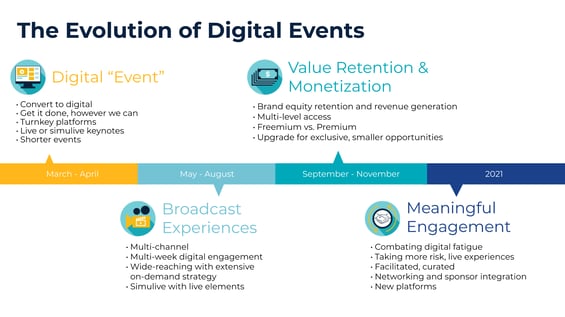As we always do when we flip to the last page of our calendars, we like to take stock of what’s transpired within our company, industry and world over the course of the year.
And what a year this one has been!
Though it started off innocuous enough, we were quickly thrown head-first into the chaos and cacophony now known as the COVID-19 Global Pandemic, which continues to serve up unexpected turns and unprecedented change for the event industry (and the world at large).

By March 4, our event experts’ audit of how the industry was responding was well underway. We took a deep look into more than 80 events hosted by B2B enterprise technology companies that faced an inevitable transition to a digital platform.
Editor’s note: this is part three in a four-part series that explores the current reality and future possibilities within event strategy. We’ve looked beyond the idea of a “hybrid event” and suggested designing a more “integrated” experience in 2021 and we’ve discussed the types of content that work well for digital vs. in-person audiences.
Next up: what has forever changed for our industry.
Since then, we’ve published three iterations of our observations, recommendations, and forecasts for what to expect next. Here’s an overview of big themes and consistencies we have observed this year as the world conformed to connect with audiences in new ways.
March—April
At the beginning of the pandemic with abrupt shut-downs happening across the world, companies with events scheduled in the near future were pressed to decide whether to postpone, cancel, or convert to digital—some with only a few days’ notice—and figure out how.
Contracts with venues and speakers were renegotiated. Turnkey solutions and platforms, live keynotes and short events were produced with a “get it done; make it happen” kind of mentality.
May—August
As brands began to explore the boundaries of what a digital event could be, we saw more creativity. There was a shift to a multi-week, multi-channel engagement strategy allowing audiences to interact and consume content over the course of a set period of time. This proved useful to widen reach and extend the lifespan of content that was developed with a remote audience in mind. It was here where we began to truly see the potential of digital engagement… and envision its place in future “hybrid” events. In the U.S., conversations about racial justice and equity were also top-of-mind and industry leaders were quick to take a stand and take part in important conversations, which was reflected in event design.
September—November
Though it was on the minds of many, we didn’t see much monetization of digital events until September. Brands began to explore freemium vs. premium opportunities, asking audiences to pay for exclusive, smaller, VIP experiences. This worked well and supported value creation—essential to any company’s offerings and the hallmark of good event design.
December and into 2021…
Here, today, we find ourselves combating a severe onset of digital fatigue and searching for that perfect sweet spot to initiate meaningful engagement with audiences. Companies that are willing to take more risks with live experiences and to create highly-curated smaller engagements will reap the benefits. We’re also seeing broadcast-style production values, new platforms and innovative tools. Creating an integrated experience that thoughtfully combines in-person and digital experiences will be essential as we begin to think about the return to in-person events. Will we see more Virtual Reality, Augmented Reality and continued pressure to entertain and engage in 2021?
We think so.
Our next post will explore what has forever changed in event strategy, so stay tuned.
Need some inspiration to produce your next engaged, aligned, effective event? Let our IPG experts lead the way. Visit impactpointgroup.com to get started.

